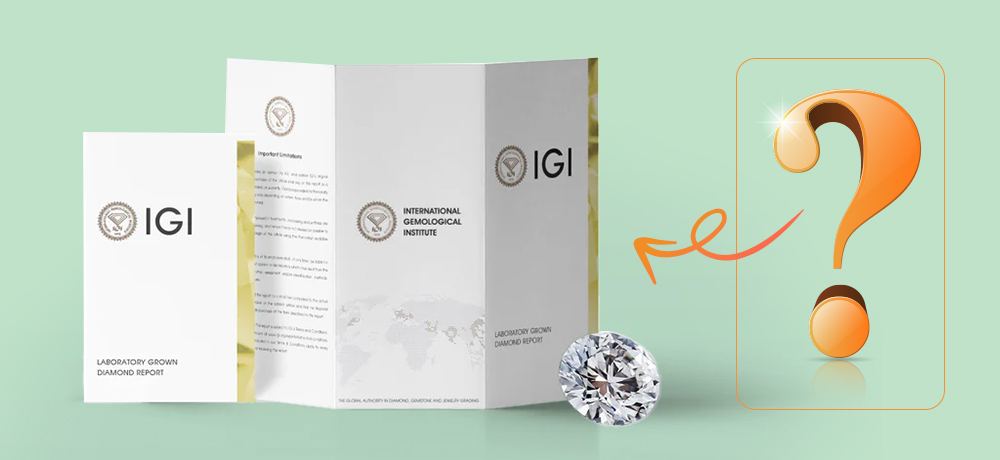Lab Grown Diamond Certification: IGI, GIA, and Why It Matters
What is Diamond Certification?
Diamond certification refers to the assessment and evaluation of diamonds provided by an authorized and internationally accredited laboratory. The laboratories conceptualize their findings in a report comprising all the single diamond’s physical and characteristic features. Apart from the important properties of the gemstone, the laboratories also analyze the performance of the diamond based on these properties. Hence, certification is an important part of the procedure of diamond purchase.
The authorization of Lab Grown Diamonds is similar to that of natural diamonds. Laboratories follow the exact methodology and medium as part of the evaluation. However, they demarcate the difference between a Lab-Grown diamond and a natural diamond in favor of and for the ease of the customers. But how do gemologists differentiate between Lab grown and natural diamonds?
How Lab grown and Natural diamonds established?
Although Lab Grown diamonds and Natural diamonds share the same physical and chemical properties, there are certain minuscule and microscopic differences between the two. For example, most of the naturally occurring diamonds possess elements of nitrogen in their chemical composition, despite being completely indistinguishable from lab grown diamonds in their physical form.
Gemologists use this ‘lack of nitrogen’ in order to compare and establish the difference between a lab grown and a natural diamond. In a similar way, the crystal growth is also observed to be an important facet in understanding the difference between a lab created diamond and an earth-mined diamond.
Earth-mined diamonds also have a peculiar feature, that is, trace elements. Sometimes lab created diamonds also comprise trace elements, but it is mostly unlikely to have trace elements play a greater role than they do in natural ones. While a diamond encompasses 99.95% of carbon in its chemical form, the other 0.05% is attributed to trace elements.
Basically, trace elements are not a part of the chemical composition, but the presence of these atoms has a huge impact on the physical color and the shape of the diamond. The catch here is that, in the case of lab grown diamonds, the trace elements do not largely influence the physical properties of the diamond. Gemologists, thus, also take this into account while assessing the difference between lab grown and natural diamonds.
As we can see, it is almost impossible to distinguish between a natural diamond and a Lab grown diamond with an unaided eye. Only with the help of highly specialized instruments and under controlled laboratory conditions can one assess, evaluate, grade, and certify diamonds. Hence, it is important that your diamonds are certified by reliable and authorized sources.
Lab Grown Diamonds Grading
The grading is based on the 4Cs of a diamond- Cut, Clarity, Color, and Carat. As mentioned, a single diamond is individually tested and graded by the gemologist and authenticated by the respective lab. Sometimes, a diamond undergoes more than one grading in order to attain the correct grade and certificate. The individual findings of single diamonds are further culminated into a report that comprises all the information regarding the diamond. This elaborate process is the most important part of purchasing and owning a diamond.
Authorities that grade Lab Grown Diamonds
Lab grown diamond certifications are provided by a number of internationally approved laboratories- International Gemological Institute (IGI), Gemological Institute of America (GIA), Antwerp World Diamond Center (AWDC), Gem Certification and Assurance Lab (GCAL), American Gem Society (AGS), and Gemological Science International (GSI). All of these laboratories use similar standards of grading scales and assessment in providing diamond certificates.
However, there can be minor differences in their reports due to different measures and conception of a grade in a specified category. For example, one lab may consider a diamond to be an I, while another laboratory might grade the same diamond as a J. The reason for such a difference is that diamond gradings are subjective in nature, and hence, it is not preferred to compare the certifications of two diamonds graded in different laboratories. Otherwise, if the findings remain consistent, the assessment of both labs is appropriate and reliable.
Why IGI Certification for Lab Grown Diamonds?

In the context of lab Diamonds, IGI certifications are usually preferred by most companies. We included, provide a wide range of lab grown diamonds at Finegrown Diamonds that are certified by IGI. Although GIA is the most renowned and cherished grading authority worldwide for natural diamonds, IGI is recommended mostly for lab grown diamonds because IGI provides a more elaborate and peculiar range for the grading of diamonds. This enables a deeper understanding of the diamond, its features, and its characteristics in terms of both beauty as well as performance.
IGI certification consists of several things that allow customers to understand their diamonds. This includes-
- A brief description of the diamond, which includes its type and origin.
- The shape and cut of the diamond
- The 4Cs of diamond- the Cut grade, the Clarity grade, the Color grade, and the Carat Weight
- The physical description of the diamond includes all the sectional divisions of the diamond- the table, the crown height, the pavilion depth, the girdle, and the culet
- The finish of the diamond- the polish, symmetry, and the fluorescence
In Conclusion,
Certification of a diamond is a necessity in the process of purchase. The importance of certification is not just momentary, it stands for a diamond’s identification. It signifies a diamond’s predominant features that make it remarkably different from its counterparts. As a matter of fact, no two diamonds are the same. For this reason, diamonds have a ‘gem mark’ which is like their distinctive birthmark- unmatchable to any other diamond, and hence making every diamond unique. As a consumer, knowledge about certification goes a long way in a better understanding of your purchase and also enables you to make a smart and insightful decision.

